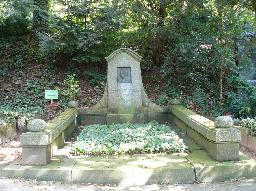Bunsen, Robert Wilhelm |
| CHEMIST (GERMANY) |
|
BORN 31 Mar 1811, Göttingen, Niedersachsen - DIED 16 Aug 1899, Heidelberg, Baden-Württemberg GRAVE LOCATION Heidelberg, Baden-Württemberg: Bergfriedhof, Rohrbacher Strasse (Abteilung V) |
|
Son of the chief librarian of the University of Göttingen Christian Buinsen (1770-1837). He studied chemistry, mineralogy and mathematics. Among his teachers was Cal Friedrich Gauss. In 1832 and 1833 he travelled in Germany, France and Austria. He became a lecturer in Göttingen in 1833 and he started experiments with metal salts of arsenous acid. His discovery of iron oxide hydrate as a precipitating agent gave the world an effective antidote against arsenic poisoning. In 1836 he became a teacher in Kassel and in 1839 he moved on to the University of Marberg, where he became a professor in 1841. He almost died from arsenic poisoning himself and he lost his right eye in a cacodyl explosion. In 1851 he became professor at the University of Breslau and in 1852 he succeeded Leopold Gmelin in Heidelberg. There he produced pure metals using electrolysis. He collaborated closely with Henry Enfield Roscoe from 1852 to 1859. His special gas burner for spectrum analysis is known as the Bunsen burner (1855). In 1860 he isolated the new element caesium and in 1861 it was followed by rubidium. Bunsen never married and retired from his work aged 78. Afterwards he studied geology and mineralogy. Related persons • was teacher of Baeyer, Adolf Ritter von • was teacher of Eötvös, Loránd • was pupil of Gauss, Carl Friedrich • was a friend of Hildebrand, Bruno • was teacher of Mond, Ludwig |
Sources • Wallace, Irving, Amy, Sylvia & Wallechinsk, David, Lijstenboek 2, 1983 • Winkler Prins Encyclopedie (editie 1909), 1909 • Robert Bunsen - Wikipedia (EN) |



